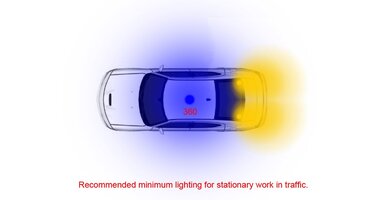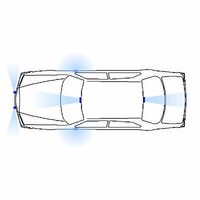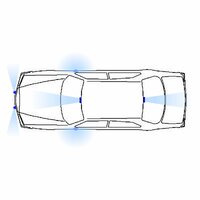Having viewed a ton of installs on here and reading peoples comments, I realize there are a lot of opinions on what is enough warning-lights and how they should be placed on vehicles. I also realize this is a place for many newcomers looking for advice, but there is no comprehensive guide, just tons of more or less good advice buried in dozens of threads, often focusing on whats wrong, rather than whats right. Hence the:
Illustrated guide to adequate lighting.
Feel free to contribute, but please keep your opinions to your self if you´re not willing to take a minute to back it up with pictures, videos or illustrations:yes: Ohh, and no rants or fights :nono:
So to kick it off with my recommendations:
360-degree coverage
All emergency vehicles should have full 360-degree coverage. This is mandated by law many places.

The simplest way to achieve this is by using a beacon, like in the old days. However, a minibar or full lightbar will offcourse be better.
If you drive a tall vehicle, remember that the beacon can be hidden to vehicles close to you, and you may need two beacons diagonally mounted. The same problem applies to minibars and lightbars, so you might need to add some additional lighting to the sides, front or rear.
If you replace the roof-mounted light with interior lights, remember that you still need adequate warninglights facing to the sides. Also: consider the "viewing-angle" of the light you install: a vertically mounted Tir-style module will give a very narrow spread of light, some as little as 5o, where as a horisontally mounted Linear-style module wil give a much wider spread of light, some as much as 180o. This greatly effects the effectiveness of your side warning.


Interior lights that are used as a replacement for a beacon or lightbar, should be mounted as high a possible, preferably towards the top of the window where possible. This will minimize the chance of having the lights being hidden/obstructed by ground-objects and other vehicles.
"Width"
When navigating through dense traffic, remember that only a small part of your vehicle may be visible to oncoming drivers. Since anyone can flash their headlights, it is recommended to also put colored warninglights towards the sides/corners of your vehicle, facing forwards. Same problem applies from the rear when stationary in traffic. This will give you a wider, and more visible install.

This can be achieved with Haws (hide-aways) in vehicle lights or surfacemounted, lights under or on the sideview mirrors, a wide lightbar or decklights in the corners of your windshield. ...to mention some.
Front intersection warning
One of the more dangerous situations when responding is navigating intersections, especially red lights or intersections where others have the right of way. Your approach to and placement in the intersection is important, but many intersections, especially in dense urban areas, may obstruct your approach and offer little room to navigate within. If your vehicle is partially hidden by other vehicles, your lightbar or sidemounted warninglights may not be visible, and since your siren is pointing forward it may be virtually impossible for some motorists to see/hear that you are responding. Hence, it is recommended to mount some form of outward-facing warninglights towards the front of the vehicle.


This can be achieved with Haws (hide-aways) in vehicle cornerlights or surfacemounted on the side of the bumper, outward-facing modules in the grille or on the side of a pushbumper. ...to mention some.
Avoid flashing or interfering with your turn signals as you aught to use them in communicating with oncoming traffic when driving, even on response (standard curriculum in emergency driving courses)!
Some lights will cover both width and front intersection warning, such as properly places Haws in vehicle cornerlights or surface-mounted lightheads on the side of bumper.
A very minimal install could look like this:


EDIT: AMBER is a very effective warningcolor, when it is not necessary to display any color that signals "right-of-way" or "stop", such as red and/or blue (depending on location). Hence many departments are moving towards only flashing amber to the rear when stationary along the roadside, either on arrow or split pattern. The result is often a smoother flow of traffic past the scene. Red and/or blue is still used when responding, conducting traffic-stops or at a scene where vehicles are required to come to a full stop.
Nighttime low-power option
If your vehicle is equipped with a lot of warninglights, it is highly recommended that some or all of these can be turned down during the darker hours, to avoid blinding other drivers.
The idea that blinded drivers will slow down is false! Some simply carry on, either from stupidity or confusion, and will not be able to see officers in the best of reflective gear. Studies have also indicated that drivers tend to veer towards where they are focused.
Think of your car: it has driving lights and parkinglights, and in driver-education you probably learned to turn off your driving-lights when parked, to allow for other drivers to see the contours of your vehicle and any people or other vehicles next to or behind it. The same applies to warning-lights. DO NOT BLIND OTHER DRIVERS!
EDIT: read more here: http://elightbars.org/forums/f13/too-many-lights-cause-accidents-42203/
Keep it slow and synced
Your car is not a discotech! Keep to slower patterns and sync your lights to give clear and distinct flashes, meaning "on and off" periods.
Using split pattern on LED-lights will also decrease the power of each flash, since your never flashing all of the LEDs at once, only half at a time. This, combined with very fast flashpatterns, is what is often called "split-fail" on here.
This especially applies to vehicles with two colors, such as red and blue. If you mix these colors with fast and/or split patterns, people will only perceive you as a "purple blob" :crazy: Reds and blues should be well separated, either by time (flashpattern) or by distance (placement on vehicle)!
Avoid flashback
If you are using interior lightsbars or decklights, keep them flush with the window to avoid flashback, meaning light reflected of the glass or via the dashboard. This WILL impair your vision when driving in the dark and is a completely unnecessary risk!
Check with local regulations
And to cover the obvious: If local regulations require your vehicle to meet a certain standard; comply with it!
_____
That should kick it off!
Feel free to contribute, but please keep your opinions to your self if you´re not willing to take a minute to back it up with pictures, videos or illustrations :yes: Ohh, and no rants or fights :no:
Edited Sept. 13th 2014: fixed placement of illustrations.
Illustrated guide to adequate lighting.
Feel free to contribute, but please keep your opinions to your self if you´re not willing to take a minute to back it up with pictures, videos or illustrations:yes: Ohh, and no rants or fights :nono:
So to kick it off with my recommendations:
360-degree coverage
All emergency vehicles should have full 360-degree coverage. This is mandated by law many places.

The simplest way to achieve this is by using a beacon, like in the old days. However, a minibar or full lightbar will offcourse be better.
If you drive a tall vehicle, remember that the beacon can be hidden to vehicles close to you, and you may need two beacons diagonally mounted. The same problem applies to minibars and lightbars, so you might need to add some additional lighting to the sides, front or rear.
If you replace the roof-mounted light with interior lights, remember that you still need adequate warninglights facing to the sides. Also: consider the "viewing-angle" of the light you install: a vertically mounted Tir-style module will give a very narrow spread of light, some as little as 5o, where as a horisontally mounted Linear-style module wil give a much wider spread of light, some as much as 180o. This greatly effects the effectiveness of your side warning.


Interior lights that are used as a replacement for a beacon or lightbar, should be mounted as high a possible, preferably towards the top of the window where possible. This will minimize the chance of having the lights being hidden/obstructed by ground-objects and other vehicles.
"Width"
When navigating through dense traffic, remember that only a small part of your vehicle may be visible to oncoming drivers. Since anyone can flash their headlights, it is recommended to also put colored warninglights towards the sides/corners of your vehicle, facing forwards. Same problem applies from the rear when stationary in traffic. This will give you a wider, and more visible install.

This can be achieved with Haws (hide-aways) in vehicle lights or surfacemounted, lights under or on the sideview mirrors, a wide lightbar or decklights in the corners of your windshield. ...to mention some.
Front intersection warning
One of the more dangerous situations when responding is navigating intersections, especially red lights or intersections where others have the right of way. Your approach to and placement in the intersection is important, but many intersections, especially in dense urban areas, may obstruct your approach and offer little room to navigate within. If your vehicle is partially hidden by other vehicles, your lightbar or sidemounted warninglights may not be visible, and since your siren is pointing forward it may be virtually impossible for some motorists to see/hear that you are responding. Hence, it is recommended to mount some form of outward-facing warninglights towards the front of the vehicle.


This can be achieved with Haws (hide-aways) in vehicle cornerlights or surfacemounted on the side of the bumper, outward-facing modules in the grille or on the side of a pushbumper. ...to mention some.
Avoid flashing or interfering with your turn signals as you aught to use them in communicating with oncoming traffic when driving, even on response (standard curriculum in emergency driving courses)!
Some lights will cover both width and front intersection warning, such as properly places Haws in vehicle cornerlights or surface-mounted lightheads on the side of bumper.
A very minimal install could look like this:


EDIT: AMBER is a very effective warningcolor, when it is not necessary to display any color that signals "right-of-way" or "stop", such as red and/or blue (depending on location). Hence many departments are moving towards only flashing amber to the rear when stationary along the roadside, either on arrow or split pattern. The result is often a smoother flow of traffic past the scene. Red and/or blue is still used when responding, conducting traffic-stops or at a scene where vehicles are required to come to a full stop.
Nighttime low-power option
If your vehicle is equipped with a lot of warninglights, it is highly recommended that some or all of these can be turned down during the darker hours, to avoid blinding other drivers.
The idea that blinded drivers will slow down is false! Some simply carry on, either from stupidity or confusion, and will not be able to see officers in the best of reflective gear. Studies have also indicated that drivers tend to veer towards where they are focused.
Think of your car: it has driving lights and parkinglights, and in driver-education you probably learned to turn off your driving-lights when parked, to allow for other drivers to see the contours of your vehicle and any people or other vehicles next to or behind it. The same applies to warning-lights. DO NOT BLIND OTHER DRIVERS!
EDIT: read more here: http://elightbars.org/forums/f13/too-many-lights-cause-accidents-42203/
Keep it slow and synced
Your car is not a discotech! Keep to slower patterns and sync your lights to give clear and distinct flashes, meaning "on and off" periods.
Using split pattern on LED-lights will also decrease the power of each flash, since your never flashing all of the LEDs at once, only half at a time. This, combined with very fast flashpatterns, is what is often called "split-fail" on here.
This especially applies to vehicles with two colors, such as red and blue. If you mix these colors with fast and/or split patterns, people will only perceive you as a "purple blob" :crazy: Reds and blues should be well separated, either by time (flashpattern) or by distance (placement on vehicle)!
Avoid flashback
If you are using interior lightsbars or decklights, keep them flush with the window to avoid flashback, meaning light reflected of the glass or via the dashboard. This WILL impair your vision when driving in the dark and is a completely unnecessary risk!
Check with local regulations
And to cover the obvious: If local regulations require your vehicle to meet a certain standard; comply with it!
_____
That should kick it off!
Feel free to contribute, but please keep your opinions to your self if you´re not willing to take a minute to back it up with pictures, videos or illustrations :yes: Ohh, and no rants or fights :no:
Edited Sept. 13th 2014: fixed placement of illustrations.
Last edited by a moderator:








